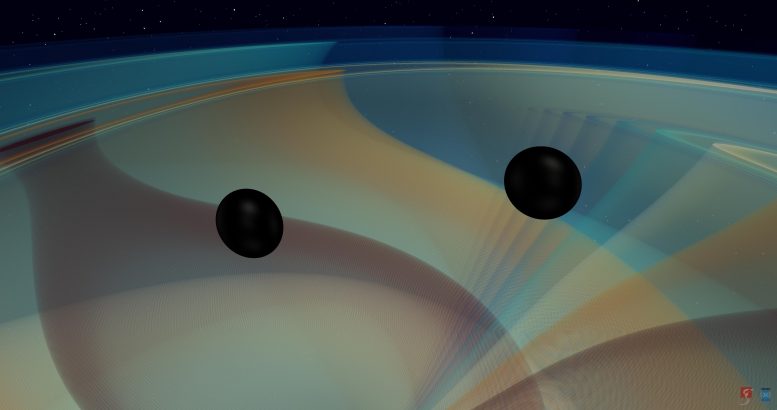
Numerical simulation of two black holes that inspiral and merge, emitting gravitational waves. The black holes have large and nearly equal masses, with one only 3% more massive than the other. The simulated gravitational wave signal is consistent with the observation made by the LIGO and Virgo gravitational wave detectors on May 21, 2019 (GW190521). Credit: N. Fischer, H. Pfeiffer, A. Buonanno (Max Planck Institute for Gravitational Physics), Simulating eXtreme Spacetimes (SXS) Collaboration
Scientists Detect First-of-Its-Kind ‘Intermediate-Mass’ Black Hole
An international research collaboration including Northwestern University astronomers has witnessed the birth of an “intermediate-mass” black hole. This is the first conclusive discovery of an intermediate-mass black hole, an object which has long eluded astronomers. The cosmic event, its energy detected on Earth in the form of gravitational waves, is the most massive black hole merger yet observed in gravitational waves.
Two black holes likely collided and merged to create a more massive black hole with a final mass 142 times that of the sun, or 142 solar masses. This final black hole is the first to be found in an intermediate-mass range that lies between stellar mass and supermassive black holes.
Another first is that the heavier of the two merging black holes, at 85 solar masses, is the first black hole so far detected within what is known as the “pair-instability mass gap.”
This video shows a numerical simulation of two black holes that spiral inwards and merge, emitting gravitational waves. The simulated gravitational wave signal is consistent with the observation made by the LIGO and Virgo gravitational wave detectors on May 21st, 2019 (GW190521). Credit: Copyright © N. Fischer, H. Pfeiffer, A. Buonanno (Max Planck Institute for Gravitational Physics), Simulating eXtreme Spacetimes (SXS) Collaboration.
Researchers detected the gravitational-wave signal on May 21, 2019, with the National Science Foundation’s LIGO (Laser Interferometry Gravitational-wave Observatory (LIGO), a pair of identical, 4-kilometer-long (2.5-mile-long) interferometers in the United States, and Virgo, a 3-kilometer-long (1.9-mile-long) detector in Italy. The signal was dubbed GW190521.
The team of scientists, who make up the LIGO Scientific Collaboration (LSC) and the Virgo Collaboration, has reported its findings in two papers to be published today (September 2, 2020). One, appearing in Physical Review Letters, details the discovery of the gravitational wave signal, and the other, in the Astrophysical Journal Letters, discusses the signal’s physical properties and astrophysical implications.
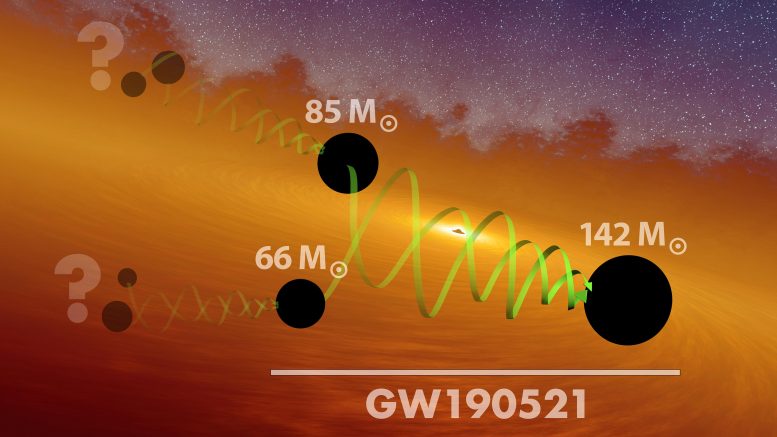
Artist concept illustrating a hierarchical scheme for merging black holes. LIGO and Virgo recently observed a black hole merger with a final mass of 142 times that of the sun, making it the largest of its kind observed in gravitational waves to date. The event is thought to have occurred when two black holes of about 66 and 85 solar masses spiraled into each other and coalesced. Theoretical models indicate that nature is not likely to form black holes of this heft; in particular, models identify a range of masses between 65 and 120 solar masses, called the “pair-instability mass gap,” in which it is thought that black holes cannot be formed by a collapsing star. So how did the two merging black holes observed by LIGO and Virgo originate? Scientists think that these black holes may have themselves formed from the earlier mergers of two smaller black holes, as indicated in the illustration. Credit: LIGO/Caltech/MIT/R. Hurt (IPAC)
Christopher Berry, the CIERA Board of Visitors Research Professor in Northwestern’s CIERA (Center for Interdisciplinary Exploration and Research in Astrophysics), was an LSC Editorial Board reviewer for the discovery paper. Chase Kimball, also an LSC member and a Northwestern astronomy Ph.D. student, contributed to the analysis of the astrophysical origins of GW190521 in the implications paper. Kimball is co-advised by Berry and Vicky Kalogera, the principal investigator of Northwestern’s LSC group, director of CIERA and the Daniel I. Linzer Distinguished University Professor of Physics and Astronomy in the Weinberg College of Arts and Sciences.
“One of the great mysteries in astrophysics is how supermassive black holes form?” Berry said. “They are the million solar-mass elephants in the room. Do they grow from stellar-mass black holes, which are born when a star collapses, or are they born via an undiscovered means? Long have we searched for an intermediate-mass black hole to bridge the gap between stellar-mass and supermassive black holes. Now, we have proof that intermediate-mass black holes do exist.”
The signal of GW190521, resembling about four short wiggles, was extremely brief in duration, lasting less than one-tenth of a second. From what the researchers can tell, it was generated by a source that is roughly 5 gigaparsecs away, when the universe was about half its current age, meaning that the signal traveled across space for 7 billion years before reaching Earth. GW190521’s source is the most distant gravitational-wave source detected so far.
“This doesn’t look much like a chirp, which is what we typically detect,” said Virgo member Nelson Christensen, a researcher at the French National Centre for Scientific Research, comparing the signal to LIGO’s first detection of gravitational waves in 2015. “This is more like something that goes ‘bang,’ and it’s the most massive signal LIGO and Virgo have seen.”
Almost every confirmed gravitational-wave signal to date has been from a binary merger, either between two black holes or two neutron stars. This newest merger appears to be the most massive yet, involving two inspiraling black holes with masses about 85 and 66 solar masses.
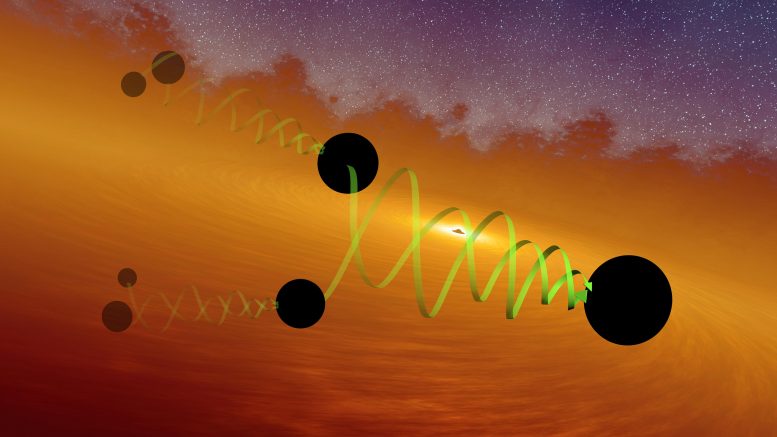
Artist concept illustrating a hierarchical scheme for merging black holes. LIGO and Virgo recently observed a black hole merger with a final mass of 142 times that of the sun, making it the largest of its kind observed in gravitational waves to date. The event is thought to have occurred when two black holes of about 66 and 85 solar masses spiraled into each other and coalesced. Theoretical models indicate that nature is not likely to form black holes of this heft; in particular, models identify a range of masses between 65 and 120 solar masses, called the “pair-instability mass gap,” in which it is thought that black holes cannot be formed by a collapsing star. So how did the two merging black holes observed by LIGO and Virgo originate? Scientists think that these black holes may have themselves formed from the earlier mergers of two smaller black holes, as indicated in the illustration. Credit: LIGO/Caltech/MIT/R. Hurt (IPAC)
“Gravitational-wave observations are revolutionary,” Berry said. “Each new detection refines our understanding of how black holes form. With these gravitational-wave breakthroughs, it won’t be long until we have enough data to uncover the secrets of how black holes are born and how they grow.”
The LIGO-Virgo team has also measured each black hole’s spin and discovered that as the black holes were circling ever closer together, they could have been spinning about their own axes, at angles that were out of alignment with the axis of their orbit. The black holes’ misaligned spins likely caused their orbits to wobble, or “precess,” as the two Goliaths spiraled toward each other.
The new signal likely represents the instant that the two black holes merged. The merger created an even more massive black hole, of about 142 solar masses, and released an enormous amount of energy, equivalent to around 8 solar masses, spread across the Universe in the form of gravitational waves.
“LIGO once again surprises us not just with the detection of black holes in sizes that are difficult to explain, but doing it using techniques that were not designed specifically for stellar mergers,” said Pedro Marronetti, program director for gravitational physics at the National Science Foundation. “This is of tremendous importance since it showcases the instrument’s ability to detect signals from completely unforeseen astrophysical events. LIGO shows that it can also observe the unexpected.”
In the mass gap
The uniquely large masses of the two inspiraling black holes, as well as the final black hole, raise a slew of questions regarding their formation.
All of the black holes observed to date fit within either of two categories: stellar-mass black holes, which measure from a few solar masses up ¬to tens of solar masses and are thought to form when massive stars die; or supermassive black holes, such as the one at the center of the Milky Way galaxy, that are from hundreds of thousands to billions of times the mass of our sun.
However, the 142-solar-mass black hole produced by the GW190521 merger lies within an intermediate mass range between stellar mass and supermassive black holes. And the two black holes that produced the final black hole also seem to be unique in their size. They’re so massive that scientists suspect one or both of them may not have formed from a collapsing star, as most stellar-mass black holes do.
According to the physics of stellar evolution, outward pressure from the photons and gas in a star’s core support it against the force of gravity pushing inward, so that the star is stable, like the sun. After the core of a massive star fuses nuclei as heavy as iron, it can no longer produce enough pressure to support the outer layers. When this outward pressure is less than gravity, the star collapses under its own weight, in an explosion called a core-collapse supernova, which can leave behind a black hole.
This process can explain how stars as massive as 130 solar masses can produce black holes that are up to 65 solar masses. But for heavier stars, a phenomenon known as “pair instability” is thought to kick in. When the core’s photons become extremely energetic, they can morph into an electron and antielectron pair. These pairs generate less pressure than photons, causing the star to become unstable against gravitational collapse, and the resulting explosion is strong enough to leave nothing behind. Even more massive stars, above 200 solar masses, would eventually collapse directly into a black hole of at least 120 solar masses. A collapsing star, then, should not be able to produce a black hole between approximately 65 and 120 solar masses — a range that is known as the “pair-instability mass gap.”
But now, the heavier of the two black holes that produced the GW190521 signal, at 85 solar masses, is the first so far detected confidently within the pair-instability mass gap. Astrophysicists think of black holes forming from stars collapsing, but an 85-solar-mass black hole should be impossible this way, Northwestern’s Berry said.
“There are many ideas about how to get around this — merging two stars together, embedding the black hole in a thick disc of material it can swallow, or primordial black holes created in the aftermath of the Big Bang,” he said. “The idea I really like is a hierarchical merger where we have a black hole formed from the previous merger of two smaller black holes.”
A hierarchical merger, in which the two progenitor black holes themselves may have formed from the merging of two smaller black holes, before migrating together and eventually merging, is one possibility which the researchers consider in their second paper. Kimball, Berry, and Kalogera have been studying hierarchical mergers guided by independent theoretical predictions by other researchers at Northwestern.
“After so many gravitational-wave observations since the first detection in 2015, it’s exciting that the universe is still throwing new things at us, and this 85-solar-mass black hole is quite the curveball,” Kimball said.
For the implications paper on GW190521, Kimball calculated the merger rates, one of the key pieces of information for the astrophysical interpretation, and led the calculation of the probability that the source is the result of a hierarchical merger. The odds for or against a hierarchical merger are roughly even when considering mergers in globular clusters, dense balls of hundreds of thousands of stars and black holes, but the odds may be better for a merger in the dense heart of a galaxy.
Discussing results, Kimball said, “While GW190521’s origin is a mystery, I’m particularly excited about the prospect of it being the result of a hierarchical merger. In the future, with more binary black hole mergers and a better understanding of the pair-instability mass gap, we should be able to tell more definitively whether GW190521’s big black hole was itself the product of a previous merger.”
“This event opens more questions than it provides answers,” said LIGO member Alan Weinstein, professor of physics at the California Institute of Technology. “From the perspective of discovery and physics, it’s a very exciting thing.”
‘Something unexpected’
There are many remaining questions regarding GW190521.
The LIGO and Virgo detectors can detect gravitational-wave signals from many sources. In the case of GW190521, the signal is sufficiently short that it may be interpreted as something other than a binary of black holes, opening the very small chance that the gravitational waves arose from a new source other than a binary merger.
“What if something entirely new produced these gravitational waves?” Kalogera said. “It’s a tantalizing prospect, and in the implications paper, the scientists briefly consider other sources in the universe that might have produced the signal they detected. For instance, perhaps the gravitational waves were emitted by a collapsing star in our galaxy. The signal also could be from a cosmic string produced just after the universe inflated in its earliest moments — although neither of these exotic possibilities matches the data as well as a binary merger.”
The LIGO and Virgo detectors finished their latest observing run this past March. Data from this period are still being analyzed and are expected to contain many more gravitational-wave signals. The detectors are planned to resume observing next year after work is done to increase their detection range; the LIGO and Virgo detectors also will be joined for the first time by the Japanese KAGRA detector. The enhanced global detector network is expected to make more gravitational-wave discoveries than ever before.
“We’re really in the dawn of gravitational-wave astronomy,” graduate student Kimball said. “It’s hard to pick a better time to come up as an astrophysicist.”
References:
“GW190521: A Binary Black Hole Merger with a Total Mass of 150 M⊙” by R. Abbott et al. (LIGO Scientific Collaboration and Virgo Collaboration), 2 September 2020, Physical Review Letters.
DOI: 10.1103/PhysRevLett.125.101102
“Properties and Astrophysical Implications of the 150 Solar Mass Binary Black Hole Merger GW190521” by R. Abbott, T. D. Abbott, S. Abraham, F. Acernese, K. Ackley, C. Adams, R. X. Adhikari, V. B. Adya, C. Affeldt, M. Agathos … 2 September 2020, Astrophysical Journal Letters.
DOI: 10.3847/2041-8213/aba493

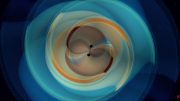
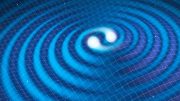
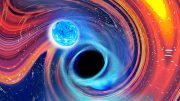
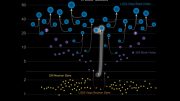
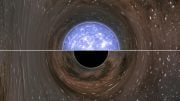

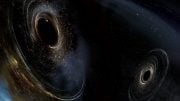

So what happens when gravity waves interfere with each other? What happens when a gravity wave hits Young’s slits or a diffraction grating? Do gravity waves red shift…….?
Two gravitational waves should interfere with each other like two light waves. Essentially the effects from the two waves would add up at each point in space.
Gravity waves should also red shift as it travels long distances.
Young’s slit experiment would be hard because what would block gravitational waves?
I’m imagining that four hyperdense objects (BHs or N/Q/P Stars) would need to be in a specific alignment to act as the Slits in this instance. Mayhap in two inspiraling pairs which are themselves caught in an inspiraling orbit. (Although, I’m not certain what could act as the occluding medium) I think that it would really be more likely (in an extremely relative sense) to be the result of two Pairs of BH/NS mergers which (so closely intervalled in time so they) are effectively instantaneous…
The conceptual element missing, is a denser universe in the distant past. In falling matter doesn’t care if it forms star, black hole, or Intermediate-Mass Black Hole.